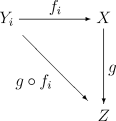Final topology
As a final topology with respect to an imaging family is known in the mathematical branch of topology , the finest topology on a set X that this family of mappings from other topological spaces by X ever makes. So the final topology is produced by "forward transmission" existing on the archetype spaces Topological the amount X . This is the application of a more general concept from category theory to topological spaces, with which important “natural spaces” such as quotient and sum spaces can be placed in a common framework. Depending on the context, one speaks ofQuotient topology or sum topology .
definition
Given a set X , a family of topological spaces and a family of pictures f i : Y i → X . A topology S on X is called a final topology with respect to the family if it has one of the following equivalent properties:
- S is the finest topology on X , with respect to which all mappings are continuous.
- A subset O of X is open (i.e. in S ) if and only if all of its archetypes are open in the respective archetype spaces.
- A function of X in a topological space is continuous if and only if is continuous for each of the family.
Remarks
The three formulations of the definition highlight different aspects of the final topology:
- Here it is viewed as the infimum of certain topologies in the association of all topologies on X : Through each individual mapping a topological structure is transferred from the archetype space to X and the final topology S is the average of all these topologies. With this definition the existence of the final topology can be proven.
- This definition is constructive. With it you can decide for any subsets of X whether they are open in the final topology. This easily results in the uniqueness of this topology.
- The abstract characterization justifies the designation “final” topology and allows these structures to be viewed in the more general framework of category theory. The initial topology can be characterized by its dual property.
Examples
- The quotient topology is the final topology with regard to the canonical projection onto the quotient space.
- The topological sum space of a family of topological spaces is the final topology on the disjoint union set of the family with respect to the canonical inclusion maps. In this case, the final topology is also called the sum topology .
- The combination of the sum and quotient space formation, ie the "gluing" of several topological spaces, can be done in one step with the final topology.
literature
- Boto von Querenburg : Set theoretical topology. 2nd revised and expanded edition. Springer, Berlin a. a. 1979, ISBN 3-540-09799-6 ( university text ).










